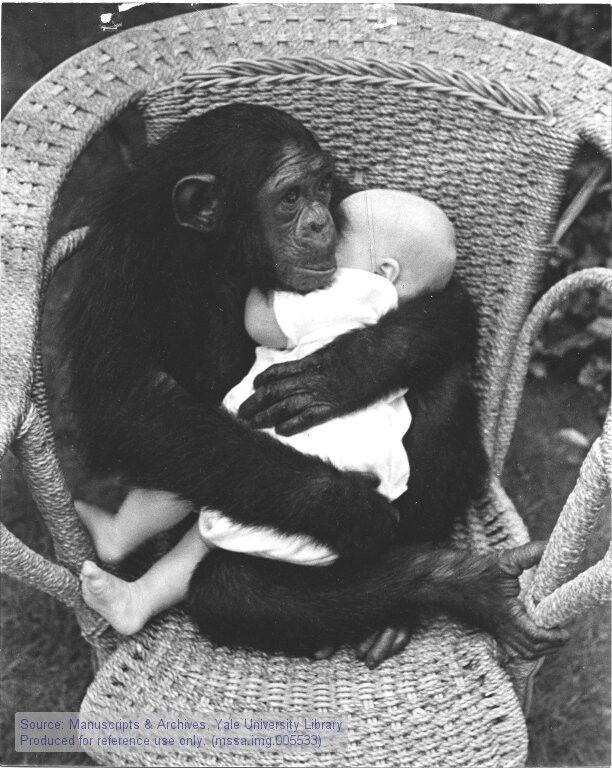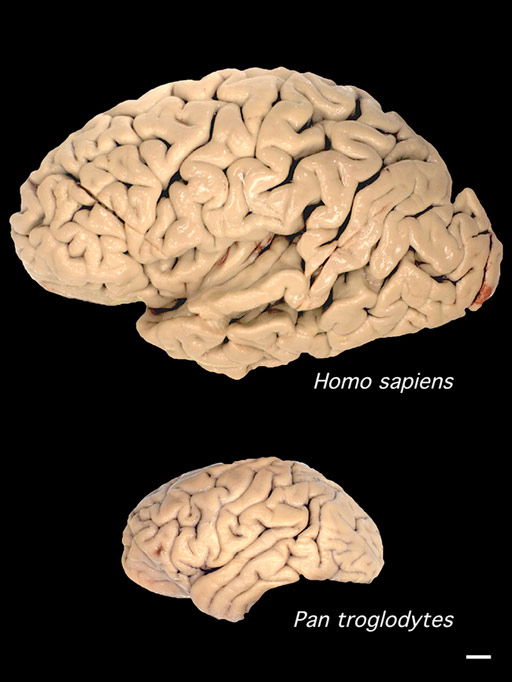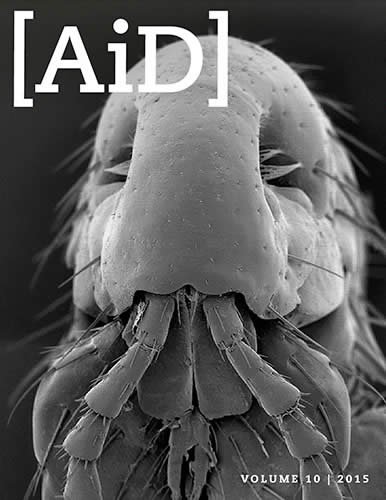
Did the Human Brain Evolve the Ability to Evolve ?
News to Know
Abstract
Evolutionists claim human intelligence, culture, and society evolved because an ape-like ancestor’s brain evolved the need to be shaped by parents and the environment.
News Sources
Chimpanzees, living in the 2037 world imagined by science fiction author Arthur C. Clarke,1 have been reclassified as Homo and granted full rights as persons. An evolutionary worldview—the belief that humans and chimps are close cousins evolved from a common ancestor—is the basis of this fiction. Yet even in that fictional future, as now, chimps and humans differ radically in behavior and intelligence. If chimps and humans share a common ancestor, how did humans get their bigger, better brains? Enquiring evolutionary minds want to know!
Evolutionists comparing chimp and human brains think they’ve found the answer. And while they have found physical manifestations of the unique, highly adaptive nature of the human brain, to claim they’ve answered the evolutionary question of its origin is another thing entirely. Nevertheless, their study is quite interesting for those amazed at the potential of a helpless human baby to quickly grow into a bright and clever child. Moreover, they shed light on how identical twins differ.

Robert Mearns Yerkes papers, 1822–1985 (inclusive). Manuscripts & Archives, Yale University
As this picture illustrates, chimpanzee infants are actually more developed than human infants. This photograph was taken by scientific illustrator and natural historian Henry Cushier Raven (1889–1944). He purchased the infant chimpanzee Meshie in the Congo in 1929 and raised her with his family until she was transferred to a Chicago zoo as an adult. In a related story, psychologist William Niles Kellogg and his wife in 1931 raised the chimpanzee infant Gua with their own baby for nine months, exposing them to the same challenges and stimuli. Gua initially developed more quickly than the human baby and outperformed him in many skill tests,2 but then, as Smithsonian.com explains, “Gua hit a cognitive wall: no amount of training or nurturing could overcome the fact that, genetically, she was a chimpanzee. As such, The Psychological Record authors write, the Kelloggs’ experiment ‘probably succeeded better than any study before its time in demonstrating the limitations heredity placed on an organism regardless of environmental opportunities as well as the developmental gains that could be made in enriched environments.’”3 As this story illustrates, chimps start out ahead but human children soon outstrip them. Knowing that and believing chimps and humans share a common ancestor, evolutionists are suggesting that human newborns took a developmental leap backward in order to evolve their vastly greater brain potential.
Nature Versus Nurture
Human newborns cannot jump up and walk like many newborn animals, largely because their brains have not yet reached the necessary neurological milestones. They simply aren’t “wired” to walk or talk, but they are ready to grow and be shaped by their world. Human newborns’ brains have all their nerve cells in place but dramatically increase in size and organizational connections after birth. Stimulation and interaction with their surroundings influences the development of the complex interconnections at the root of human intelligence. A rich environment surrounded by affectionate caregivers affects the emotional and intellectual development of a young child.4 Evidence suggests that at least part of the way this occurs is through a literal “shaping” of the brain, or rather the connections within it.
Chimpanzee babies are much less helpless at birth but—figuratively at least—never reach the heights human babies eventually attain. Why the difference? Why can human babies, born with such apparent disadvantages, change so much more dramatically than chimpanzees as they grow?
Chimpanzee brains, researchers reporting in Proceedings of the National Academy of Sciences have found, are not nearly as malleable as human brains. Using an MRI X-ray scanner, the scientists examined the brains of 218 humans and 206 chimpanzees. They compare the brains of same-species counterparts who are closely related—human identical twins, who are of course genetically matched, as well as fraternal twins and other sibling pairs. For chimps, identical twins are rather hard to come by, so they compare the brains of mother-offspring pairs and half-siblings. They examine not just the size of the brains in each pair but also the detailed shapes of comparable brain parts, like the wrinkles in the brain’s cortex.5
By comparing the brains of genetically identical or similar individuals, the scientists hoped to see just how much variation in the pre-programmed genetic layout of the brain could be shaped by environment and experience. The scientists found the human brain’s size is genetically determined, but the organization of the human brain varies significantly even between identical twins. Significant structural differences were found in regions associated with language, attention, and memory, primarily in the “association areas” that connect sensory and motor regions of the brain.6
The authors suspect these differences reflect “underlying microstructural changes in neural circuitry,”7 presumably the results of differing experiences during childhood.
Genetically similar chimpanzees, on the other hand, have very little detectable variation in brain development. Their brain organization seems largely pre-programmed by their genetic blueprints.
“We found that the anatomy of the chimpanzee brain is more strongly controlled by genes than that of human brains, suggesting the human brain is extensively shaped by its environment no matter its genetics,” says lead author Aida Gómez-Robles.8 “The human brain appears to be much more responsive to environmental influences," she explains. “It's something that facilitates the constant adaptation of the human brain and behavior to the changing environment, which includes our social and cultural context.”9

Image by Todd Preuss, Yerkes Primate Research Center, via Wikimedia Commons.
These models of the chimpanzee and human brains show the relative size and wrinkle patterns typical of their brain’s cortex. The specific wrinkle pattern in human adults varies, particularly in regions of the brain associated with language, memory, and attention. Chimpanzee brains, by contrast, are organized in accordance with the dictates of their genes.
Plasticity and People
The ability of the brain to be shaped by the environment is called plasticity. This study demonstrated that chimpanzee brains are not particularly plastic while human brain connections individualize and adapt as they grow.
Brain plasticity alone does not, of course, explain the dramatic differences between chimpanzee and human cognitive abilities. There are substantial differences between the human and the chimpanzee brain structure and size. In addition to these distinctive anatomic differences, the much greater plasticity of the human brain likely endows humans with the potential to attain the high level of intellectual, emotional, and behavioral complexity characteristic of humans. Human brain plasticity may also contribute to the individual differences between people and fit individuals to the culture in which they are raised.
But why are human brains so much more malleable than chimpanzee brains? The authors of the PNAS study believe that humans evolved their brainpower by evolving the ability to be born with increasingly immature brains, reserving their social, intellectual, and emotional development for their formative years. Many evolutionists have even asserted that humans had to evolve the ability to be born with heads substantially smaller than their large adult size because the wide pelvis necessary to deliver a large baby’s head would limit the efficiency of bipedal walking and running—a historically popular claim that has been recently overturned. While the authors of the current study opt out of this controversy, they do assert that the greater plasticity of the human brain evolved as the evolving primate brain got bigger, “providing an anatomic basis for behavioral and cognitive evolution.”10 In other words, they think evolving humans leapt ahead of the intellectual limits of primitive ape-like ancestors by evolving the ability to be born helpless, adaptable, and fully dependent on their parents. Not acknowledging the fact that our Creator actually designed human brain plasticity, they contend that this was the anatomic basis for the evolution of human intelligence and society.
Proof in the Fossils?
In common with most evolutionists, these scientists have examined observable differences in the present to make claims about the unobservable, untestable past. The journalist covering the PNAS study for Science asserts that the fossil record makes the case for the integral role of evolving plasticity in the evolution of the human brain. He writes,
The scientists also point out that this pattern of delayed development appears to have increased over evolutionary time, with our hominid ancestors presumably slowly gaining larger, more plastic brains relative to modern chimpanzees. The proof for this comes from fossil evidence, which shows that the neocortex expanded and reorganized over time in early hominins.11
However, while the authors of the study are wholly sold on the evolutionary significance of their findings, they offer no fossil evidence to support their claims.12 The brain size of juvenile Neanderthals and Homo erectus can be estimated from endocranial casts, although inferences about their wrinkles and other organizational details are severely limited. The authors acknowledge that the pattern of brain development in Neanderthal children matches that of modern humans. And while some studies have asserted the Homo erectus pattern of brain maturation was transitional between that of chimps and modern humans, later analyses have shown that the assumptions on which this contention was based were not correct. Early childhood brain development in Homo erectus and Neanderthals likely followed the same pattern seen in modern humans.13 This similarity, authors of the PNAS study write, suggests ancient human ancestors “shared the anatomical bases for social learning and cultural accumulation that are related to human cognitive evolution.” And indeed they did share the anatomical basis for learning and cultural accumulation, but that has nothing to do with human evolution!14
How Neanderthals have come up in the world from the time when they were seen as mere grunting brutes! Of course, this comes as no surprise to Bible-believers who understand that Homo erectus and Homo neanderthalensis were just varieties of the human beings that populated the world after the global Flood and the dispersion from the tower of Babel. There is every reason—scientifically and biblically—to believe that ancient people like these were born with the same sort of brain plasticity as newborns today.
What Is Man?
Humans are not only created “a little lower than the angels” (Psalm 8:4) but are designed with cognitive ability and potential galactically higher than apes.15 Documenting the physical basis for the extraordinary ability of the human brain to develop rapidly and dramatically during early childhood, this study shows that chimpanzees have no comparable plasticity. While the study’s authors have affirmed the uniqueness of this human characteristic, they have learned nothing about how humans got that way. They have demonstrated a distinct difference between the way chimpanzee infants and human infants develop, but they have not demonstrated an ancestral link.
Neither have they shown any way that the highly adaptive human brain evolved from anything less than human; they simply assume it did. No molecules-to-man evolution was involved in human history or explains the marvels of the minds with which God endowed human beings.
This study, with its emphasis on the helplessness of human newborns is a reminder that human beings are not animals but are made in the image of God. They are designed to need the protection and loving attention of their parents not only while inside their mothers’ bodies (Psalm 139:13–16) but also once they enter this world. As we watch the babies God entrusts to our care grow and develop in response to the nurturing care we give them, let us recall that God made every human being special. Each of us, including genetically identical twins, is a unique individual with whom God desires a personal relationship.
The author of all creation made the first two people, Adam and Eve, in His own image, distinct from the animals, on the very same day He made the land animals. Despite God’s great love for them, Adam and Eve disobeyed their Creator (Genesis 3), bringing sin and death into the good world God had made. Jesus Christ, the Son of God, later entered human history (John 3:16; Galatians 4:4) as the “last Adam” (1 Corinthians 15:45) by being born as a human being—an event we will soon commemorate with celebrations all over the world—in order to redeem all who repent and receive the salvation He purchased (1 Peter 1:18–21) for us through His sacrificial death on the Cross. May our hearts be as “plastic” and responsive to the gospel of God’s love as the tender brains of our newborns are responsive to the love and attention we shower on them.
Footnotes
- Arthur C. Clarke describes this in Sunstorm, the second book in his Time Odyssey trilogy.
- For more on this, visit http://www.itsokaytobesmart.com/post/92538252162/baby-chimp.
- Rachel Nuwer, “This Guy Simultaneously Raised a Chimp and a Baby in Exactly the Same Way to See What Would Happen,” Smithsonian, July 28, 2014, http://www.smithsonianmag.com/smart-news/guy-simultaneously-raised-chimp-and-baby-exactly-same-way-see-what-would-happen-180952171/?no-ist.
- Learn more at http://www.developingchildhood.com.au/learn.
- Wrinkles—the folds and dips in the surface of the brain’s cortex—are found in larger mammals and are associated with intelligence. Just exactly why the wrinkles form is a matter of debate. They may develop because the outer layer of gray matter—neuronal cell bodies—thickens or grows at a different rate than the deeper layer of white matter—neuronal axons. Or they may develop as the neuronal axons grow and form interconnections between parts of the brain. However they form, they dramatically increase the functional surface area of the brain’s cortex.
- A. Gómez-Robles et al., “Relaxed Genetic Control of Cortical Organization in Human Brains Compared with Chimpanzees,” Proceedings of the National Academy of Sciences 112, no. 48 (November 16, 2015): 14799–14804, doi:10.1073/pnas.1512646112.
- Ibid.
- William Hopkins, “Human Brains Evolved to Be More Responsive to Environmental Influences, Study Discovers,” Georgia State University, November 16, 2015, http://news.gsu.edu/2015/11/16/human-brains-evolved-responsive-environmental-influences-study-finds/.
- “Nature and Nurture: Human Brains Evolved to Be More Responsive to Environmental Influences,” Phys.org, November 16, 2015, http://phys.org/news/2015-11-nature-nurture-human-brains-evolved.html.
- Gómez-Robles et al., “Relaxed Genetic Control of Cortical Organization in Human Brains Compared with Chimpanzees.”
- David Shultz, “Humans Can Outlearn Chimps Thanks to More Flexible Brain Genetics,” Science, November 16, 2015, http://www.sciencemag.org/news/2015/11/humans-can-outlearn-chimps-thanks-more-flexible-brain-genetics.
- The authors of the PNAS study write that prior to their study “The study of hominin brain evolution has focused largely on the neocortical expansion and reorganization undergone by humans as inferred from the endocranial fossil record.” However, they do not claim that the endocranial fossil record provides proof of evolving plasticity. On the contrary, they cite Homo erectus and Neanderthals as examples in which the “evolving plasticity” and the evolutionary advent of helpless newborns has already taken place and produced a modern human-like pattern of brain development in children.
- The authors acknowledge that some have claimed Homo erectus babies’ brain development resembled that of chimpanzees, but they note that “other analyses have suggested that H. erectus and Homo sapiens shared similar developmental patterns.” The need to correctly interpret the age and size of the endocranial casts in order to assess the pattern of early childhood brain development is discussed in Steven Leigh, “Brain Ontogeny and Life History in Homo Erectus,” Journal of Human Evolution 50 (2006), 104–108. Additionally, Brank Hrvoj-Mihic et al. (in “Evolution, Development, and Plasticity of the Human Brain: From Molecules to Bones,” Frontiers in Human Neuroscience (October 30, 2015), doi:10.3389/fnhum.2013.00707) conclude that the pattern of brain growth in Homo erectus resembles that of modern humans, not chimpanzees as some earlier researchers claimed.
- Gómez-Robles et al., “Relaxed Genetic Control of Cortical Organization in Human Brains Compared with Chimpanzees.”
- The uniqueness of human beings consists of far more than the extraordinary ability of the brain and extends to spiritual aspects that are not the subject of this discussion. They are, however, of eternal importance and are discussed quite thoroughly in God’s Word.
Recommended Resources

Answers in Genesis is an apologetics ministry, dedicated to helping Christians defend their faith and proclaim the good news of Jesus Christ.
- Customer Service 800.778.3390
- Available Monday–Friday | 9 AM–5 PM ET
- © 2025 Answers in Genesis


